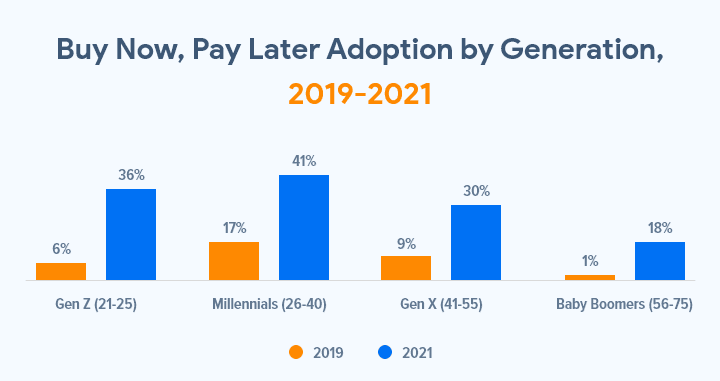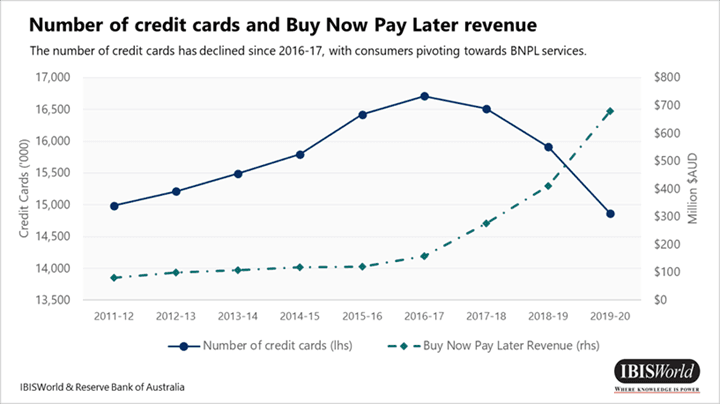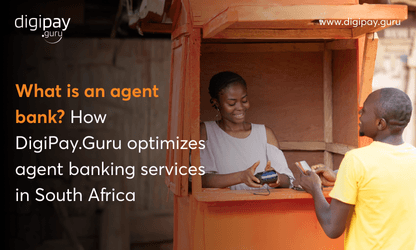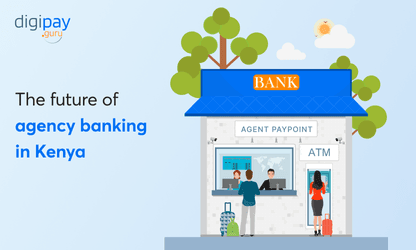AfterPay, Klarna, Affirm, and more are garnering a lot of press value in recent times as consumers show aversion towards debt accumulation. Let the number talk about the in-focus buzz of the Buy Now Pay Later app in and around the FinTech solutions.

37% of US Gen Zers and 32% of millennials have used a buy now, pay later (BNPL) service to make at least one purchase in 2023.
The above-mentioned data has been sourced from Emarketer.
Not only does the Buy Now Pay Later model become popular as an integrated solution but also as an e-wallet solution. It has joined the league of the mainstream mobile banking solutions and is now about to reign the digital payment vicinity.

Wait, there’s more. Did you know fintech businesses can adopt the Buy Now Pay Later model as an electronic payment processing system in five different ways?
We will tell you how.
What are the Five Ways to Adopt Pay Later Apps in a Business?
We have curated five ways to integrate the Buy Now Pay Later solution into a business model. Let’s understand them one by one.
Integrated Shopping Applications with eWallet Payment App
In the last decade, the fundamental behaviour with which customers shop has changed. This paradigm shift is crucial to understanding the transformation and proclivity towards online payments.
Although cash on delivery is still preferred, it only has a little bump on the chart, whereas digital payments are drawn to great heights. While payments made with credit cards, debit cards, and net banking have underlying security concerns, eWallet software has taken over the woes.
Going one step beyond the eWallet payment apps that need to be recharged from the bank accounts, the current wave of the Buy Now Pay Later software is bringing a significant revolution in the online shopping ecosystem.
With the help of the Buy Now Pay Later apps integrated within shopping apps, it becomes easier for consumers to scroll through products and finance these without having to worry about the fund in the bank.
One of the best examples of a shopping app integrated with the Pay Later system is exhibited by the Chinese player TMall. The retail giant cashes on customer engagement by offering a financing option other than the basic and advanced features of the other shipping apps, which stands out for customers.
If the traditional competitors fail to recognize and pick up on the trend and indulge in BNPL app development, it will be difficult to cut through in the fintech industry.
Off-card Solutions for Financing
If we were to pick up on predictions and trends in FinTech, off-card solutions could be seen prominently on the cards. Typically, these types of keys offer finance for a specific bracket of purchase.
Once the purchase is made, customers can repay these fintech institutes on a monthly basis. Based on the amount financed, a tenure is decided, which typically ranges between eight months to ten months.
Some of the top industry niches that are ideal for the integration of off-card solutions with the BNPL model include electronics, home goods, furniture, travel, home fitness, sports, and more.
While using an off-card solution, one of the key arguments put forth is why not prefer credit cards instead of using the new BNPL app? The reason is, nearly 80% of purchases can be made with a credit card.
However, credit interest is relatively cheaper and offers easier payment conditions. Merchants prefer to integrate these Pay Later software, sporting low-frequency purchases, wherein the cart conversions are crucial with high abandonment rates.
If you face severe cart abandonment rates, i.e., 80-90%, it is a good idea to invest in an agency banking solution with a buy now pay later solution.
Virtual Rent-to-own Model with the Buy Now Pay Later System
The rent-to-own model depicts the ultimate intent of users to buy a product after leasing or renting them till they make the payment in full. Some of the crucial benefits of rent-to-own models include no credit checks, low-rate deposits, a faster approval process, customized payment plans, and more.
Through the rent-to-own agreement model, customers are not actually lending the money. Instead, they are renting the product and owning it little by little. When the need arises, they can discontinue the payment and choose to not own the product.
Most of the players operating in the virtual rent-to-own model digitally integrate. On the other hand, the service providers seek a second and third financing option.
The buy now pay later model with the virtual rent-to-own model is flexible. Using the model, the larger issuers and lenders can identify this opportunity for enhancing the breadth of the credit boundaries.
Buy Now Pay Later Solution with Card-linked Installments
Card-linked instalments associated with the buy now pay later solution are the new-age way of financing across Latin America and Asia. However, in sheer contrast to this, U.S. card issuers have identified a new way with post-purchase instalment options.
Some of the best examples under the card-linked instalment model with the buy now pay later software include Citi Flex Pay and American Express Plan It.
In the U.S., the post-purchase instalments have the capability to acquire scale materially as they tap into the merchant-subsidized offers. In addition to this, prior to making a purchase, issuers can offer consumers the option to select the merchant transactions, which they wish to convert to instalments.
Buy Now Pay Later Model with Vertical-focused
A model similar to the buy now pay later model has worked for large players in some verticals. The model has performed exceptionally with CareCredit and GreenSky in healthcare and home improvement, respectively.
The average size of the ticket can be between USD 2000 and can exceed USD 10,000. The model preferably has worked well for selected healthcare categories such as dermatology, dental, and veterinary.
When it comes to the home improvement category, the average ticket size can be expected between USD 5,000 and USD 50,000. The model can work with particular niches such as air conditioning, ventilation, heating, etc.
One of the key ways for the home improvement companies to adopt the buy now pay later solution is through partnerships with original equipment manufacturers. Financial institutes can target this vicinity for targeting and acquiring high-credit customers.
Are there Any Regulatory Roadblocks to Implementing the Buy Now Pay Later Software?
Before exploring the regulatory norms and obstacles in the way, let’s see how the model operates. Generally, the model can be distinguished in two ways:
Merchant Model
Under the merchant model, the merchant offers the BNPL option to his customers and takes the credit risk himself.
Third-party Buy Now Pay Later Provider
Under the third-party BNPL model, the Buy Now Pay Later service provider offers the service to a customer. In such a condition, the merchant selling his products and services do not have to assume the risk of credit, but the service provider himself takes on the risk.
Since the Buy Now Pay Later system is an entirely new concept among the other mobile payment solutions, the regulatory bodies are obviously concerned about the potential disruption in the arena due to a mismatch between the credit and funds.
Let’s explore the regulatory concerns and norms across the key markets of the world:
United Kingdom
One of the biggest concerns raised by the authority of the U.K. mentioned that millions of pounds were marked as unregulated transactions.
Along with that, over 10% of customers using the Buy Now Pay Later apps were in debt or overdue. As a result, the financial scenario posed a risk.
As a part of the solution and to prevent the financial risk for a large segment of customers, the authority suggested that the products working under the Buy Now Pay Later model should be subjected to FCA credit rules, the same rule that works for the banks and lending institutes.
Under the regulation, the BNPL model would require a hard credit check as well as an affordability test before customers choose an instalment option.
United States
The U.S. authority of regulation also demands a certain level of transparency and discipline when it comes to mobile money wallets. As per a survey carried out by Credit Karma, nearly 40% of the U.S. consumers that opted for the Buy Now Pay Later model and missed even a single payment saw a decline in their credit score.
As a result, the U.S. authority suggests using the credit reporting system, wherein the lending agency can contact the credit reporting bureaus for checking the current credit standing of the customer.
Australia
As per a study by the ASIC data, the Buy Now Pay Later apps have surged and taken over the customer domain by storm.
In June 2019, the BNPL accounted spiked by 6.1 Mn, which shows that 30% of the adult population in Australia were using the model, and yet about 21% of BNPL customers missed an instalment in the last year.
The Buy Now Pay Later service providers are enjoying quite a relaxed regime in Australia as compared to the U.S. and the U.K. According to the Australian National Consumer Credit Protection Act (2009), the buy now pay later solution does not get specific types of short-term interest-free credits and loans covered.
As a result, the fintech industry has adopted a self-regulatory approach with new best practices to strengthen the trust of customers and merchants in the model.
Why is the Adoption of Buy Now Pay Later Model Suitable for your Customers?
Once you adopt the buy now pay later software for your brand, you will find the following features for your products:
Convenience
The best benefit that the BNPL model offers is convenience to use for your customers. For example, when your customers start using LazyPay, your customers are just required to download the Buy Now Pay Later app on their smartphones, sign in to the account, and identify their spending limit for initiating the first transaction.
No Upfront Payments
When it comes to seeking a loan, customers need to show their assets or job security to be eligible for the application. Therefore, it might appear time-consuming, and there are numerous kinds of upfront fees.
On the contrary, the BNPL software enables customers to make a purchase and make payments later at their convenience or the specified instalment duration with the easy EMI options.
Late Fees or Interest
Using the BNPL option, the payment has to be made during the specified duration. Generally, as more BNPL apps are emerging, the interest fees and durations are getting relaxed for customers.
As a result, customers find it easy to use the Buy Now Pay Later eWallet apps. The interest fees are nominal as compared to other credit-payment methods.
Read More: Customer loyalty programs for mobile wallet solution by digipay
What is the Adoption Trend for Buy Now Pay Later Models?
If you are looking forward to launching a new digital payment method in the form of Buy Now Pay Later app, we believe you will need substantial data of customers.
Did you know that Buy Now Pay Later is gradually surpassing the credit card system? Take a look at the graph below:

We have compiled the customer usage trends for Buy Now Pay Later apps as per a study.
-
The Buy Now Pay Later apps are more popular with males with high incomes and females with low incomes. About 92% of males with an annual income of USD 200,000 and 62% of females with an annual income of less than USD 50,000 are identified to be using the BNPL apps more, as per a study.
-
Gen-X is said to be the target audience for the BNPL model. Most of the BNPL users are married, about 63%. People aged 35 to 50 are more likely to opt for the BNPL payment.
-
Over 73% of users using the BNPL apps are employees, which means that their credit score is high as compared to the unemployed 46%.
-
About 88% of BNPL users have tried at least one peer-to-peer payment application before opting for the BNPL app. Cash App has been the most popular payment app among the other mobile payment solutions.
-
The BNPL users mostly spend money on on-demand delivery services. About 72% of BNPL users order using the on-demand delivery service at least once a week.
-
42% of the BNPL consumers are likely to spend more on holidays than they would do when it comes to self-financing for trips using the debit mode.
The Sum and the Substance
A cohort of people is wondering about the impact of fintech on banks. Are banks on the verge of getting obsolete? Are digital payments overpowering the banks and traditional financial systems?
Well, with mobile payment solutions, consumers are only getting a choice for their transactions. The new payment solutions are not going to eliminate the need for banks. They are there to actually carry out the transactions that happen in the backend.
Buy Now Pay Later apps are one of the best mobile payment solutions for consumers to make purchases without having to worry about their monthly budget. However, there is still plenty of room to improve the security of digital payments.
The electronic payment processing system might be vulnerable to prying eyes. However, the best fintech software development companies know how to tackle it the right way. So your best bet is to identify one and get onboard.
Frequently Asked Questions
How customisable is the Buy Now Pay Later app?
To make the app truly unique, we at DigiPay.Guru considers all points of customization suiting the respective business’ vision and use-cases. We provide a completely white labelled solution that would take into consideration the aesthetic preferences for the app as well.
Is there no credit check for buy now pay later apps?
Whenever you are dealing with new digital payment methods, it is crucial to have a credit check system in place to identify if the users are eligible to use the credit system and make the repayment.
Can BNPL apps with mobile money increase revenue for my business?
The BNPL is among the latest digital payment trends. It is being adopted by customers very quickly, which implies that it can increase revenue for businesses incorporating it. In addition to this, digitalization is also happening across the cities, which we know as smart cities. Hence, your mobile money wallet with the BNPL model can emerge as a smart city payment platform with the right kind of software development services.
Can BNPL model be developed as an eWallet payment app?
Certainly. You can opt for BNPL app development as a standalone mobile money wallet or eWallet payment app, or it can even be integrated with an eCommerce app.






